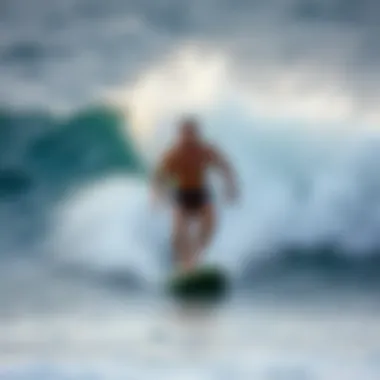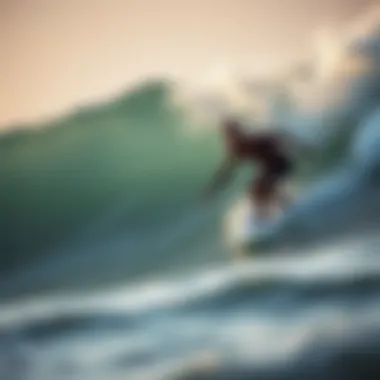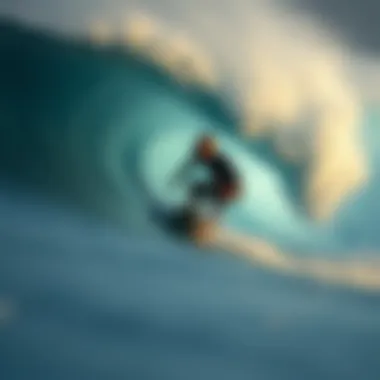Mastering Surfing Conditions for an Exceptional Ride


Intro
Surfers often look to the ocean with a sense of longing and anticipation, understanding that every wave tells a story. However, the reality of surfing extends far beyond simply paddling out into the surf. Namely, it encompasses a careful consideration of the various elements that can impact one’s ride. Understanding the nuances of surfing conditions isn’t just helpful; it’s essential for the best experience possible on the water.
The interplay of tides, wind, and swell can transform a mediocre day into something epic—or vice versa. This guide aims to shine a light on these aspects, providing surfers of all levels with insights that go beyond the basics. If you’re keen on enhancing your surfing skills, adjusting your plans based on environmental cues, or simply wanting to feel more in tune with the waves, you’ve come to the right place. Engaging with local knowledge further enriches the surfing experience, adding layers that no textbook can offer.
Armed with the right information, surfers not only ride waves but also build a deeper connection with the ever-changing ocean conditions. It's not just about the big wave competitions or the neat tricks at the beach; it’s about understanding the ocean like a second home.
Navigating the complexities of surfing conditions is an invitation to heighten your awareness. So, buckle up and prepare to dive deep into your surfing journey.
Prelude to Surfing Conditions
Surfing is not just a sport; it’s a lifestyle that draws many enthusiasts to the ocean. Understanding surfing conditions is crucial for any surfer looking to catch a wave, whether they are new to the sport or seasoned pros. Surfing conditions encompass a variety of factors such as wave height, wind speed, tide levels, and even seasonal changes. Familiarizing oneself with these elements can greatly enhance the surfing experience.
Defining Surfing Conditions
Surfing conditions refer to the collection of environmental factors that affect the quality, safety, and enjoyment of surfing. Each aspect plays a role in determining how waves break and whether it is safe to surf. For instance, the size and shape of waves, which are influenced by the wind and swells, can differ vastly from one surf location to another. Similarly, the impact of tides can change the surf line and the behavior of waves.
It's essential to grasp the nuances of these conditions. For example, a high tide might make a once surfable break unridable, while a low tide could expose rocks or reefs. Additionally, various surf locations have particular characteristics that alter how they handle specific conditions. Fortunate are the surfers who take the time to learn these subtle differences between locations. Knowing about swell direction and wind patterns can elevate a surfer’s ability to choose the right time and place for hitting the waves.
Importance of Optimal Conditions
Optimal surfing conditions can turn a mediocre day into an unforgettable experience. The significance of selecting the right surf conditions cannot be overstated. When conditions align perfectly—when the swells are substantial, the winds are gentle, and the tides cooperate—surfers can enjoy the sport's full breath-taking potential.
Surfers must also understand that not every day at the beach will yield ideal conditions. Knowledge about the forecast allows surfers to discern when their local surf will be at its best. This awareness not only aids in choosing the right days but also facilitates safer decisions when surf conditions are less than advantageous.
In essence, understanding surfing conditions provides great benefits:
- Enhances Performance: Riding waves in optimal conditions increases a surfer's performance and ability to manage different conditions.
- Improves Safety: Recognizing the hazards tied to specific conditions can prevent injuries or dangerous situations at sea.
- Maximizes Enjoyment: Knowing when to surf, what to expect, and how to adjust can amplify enjoyment.
"Knowledge is like a surfboard—without it, you might just wipe out!"
Key Elements Influencing Surf Conditions
Surfing is an art where conditions play a pivotal role in crafting the experience that surfers seek. Understanding the key elements influencing surf conditions not only allows surfers to ride waves safer but enhances the overall enjoyment they can extract from the ocean. Serve this knowledge on a silver platter to those keen on surfing, and it'll pay dividends.
Wave Height and Power
Wave height is one of the first measurements that come to mind when discussing surfing. It measures the distance from the trough to the crest, and for surfers, a solid understanding of this element is crucial. Generally, more seasoned surfers look for waves that stand tall—around 6 to 8 feet—while novices may wish to tackle the smaller waves, about 2 to 3 feet high, that offer a steadier ride.
The power of a wave is equally important. This relates to the energy a wave carries, defined largely by the wind and swell. A wave can reach impressive heights but if it lacks the necessary power, it might fizzle out before breaking. Think of it as a fierce lion— majestic from afar, yet still requires strength to perform its natural role.
Swell Direction
The direction of swell is another factor that shapes surf conditions. It's like piecing together a jigsaw puzzle. If the swell is coming from the southwest while a surf break faces east, there may not be much action to marvel at. Surf breaks will typically perform best when the swell direction aligns with the orientation of the coast and the ocean floor contours. So, knowing where the swell originates not only increases one’s chances of catching a good wave but also ensures a more thrilling surf session.
Tidal Effects
Tides are often viewed as side notes to the bigger picture of surf conditions, but their influence is profound. Tides change throughout the day and can fast alter surf quality. Generally, most surf breaks are more functional at specific high or low tides. Coming in with 'high tide', you may miss out on those spectacular waves if the break needs some space to flourish. On the flip side, at lower tides, reefs may become exposed, presenting both opportunities and hazards. Surfers ought to mind the tides like a hawk— a little understanding can mean the difference between an epic ride and a dismal day on the water.
Wind Conditions
The winds significantly impact the surf conditions as well. Ideally, surfers seek offshore winds—these are like a gentle hand caressing the ocean. They help to groom and hold the wave face, allowing for a smoother ride. On the flip side, onshore winds can wreak havoc, creating choppy and disorganized waves that can spoil an otherwise perfect day. Quite simple, isn’t it? But many surf trips have gone awry due to neglecting to check the wind conditions beforehand.


The relation between wind, tides, and waves is ever so interconnected. When looking for prime surf conditions, don’t just rely on sight. Like salt in a recipe, all elements must be in concert.
"Understanding the elements of surf conditions transforms your trip into a well-orchestrated symphony rather than a chaotic mishmash."
In summary, becoming well-acquainted with the key elements influencing surf conditions fundamentally augments the quality of the surfing experience. From wave height and power to swell direction, tidal effects, and wind conditions, every factor intertwines to create a unique canvas on which surfers can paint their adventures.
Analyzing Wave Types
Understanding the various types of waves is essential for any surfer wanting to maximize their experience in the water. Each wave type offers a distinct set of characteristics—where they're formed, how they break, and what conditions are ideal. This knowledge not only enhances the joy of riding waves but also plays a crucial role in determining safety and performance levels for surfers of all competencies.
"The type of wave influences every ride. Know your waves, ride them right."
Beach Breaks
Beach breaks occur where waves crash over a sandy bottom, commonly found along many coastlines. These waves can change their shape and behavior based on tides, swells, and wind conditions. One of the main attractions is that they usually offer a variety of peaks, meaning surfers can find different waves in close proximity. The flexible nature of beach breaks also means they can be relatively forgiving for beginners honing their skills.
However, beach breaks can be a double-edged sword. Their shifting nature means that surfers need to pay attention to the ocean's subtleties to find quality waves. As the tide moves in and out, the waves can become inconsistent, making it necessary to adapt quickly. Understanding the beach’s structure and how it interacts with surf conditions is key to riding beach breaks effectively.
Point Breaks
Point breaks are created when waves wrap around a point of land, generally offering longer rides compared to beach breaks. They often break in a predictable manner, which appeals to more experienced surfers looking to refine their skills or perform tricks. Point breaks are known for their smooth and powerfurl rides, giving surfers ample time to maneuver on the wave face.
Local knowledge about a specific point break is invaluable. Each spot may have unique conditions based on factors like gradient and the surrounding geography. Also, these waves can change significantly with different swells, sometimes offering exhilarating rides or extremely challenging conditions. Surfers should invest time observing how these changes affect the waves to truly grasp the point break vibe.
Reef Breaks
Reef breaks occur over coral or rocky reefs, creating fast and powerful waves that usually break in a more consistent pattern. They are admired for their sharp, hollow waves and are often preferred by those seeking a serious challenge. Aminant factors include swell direction and tide levels that determine how surfable these reefs are.
While reef breaks can provide some of the most exhilarating surf experiences, they come with their risks. The shallow water often leads to hazardous impacts if a surfer falls or is wiped out. Knowledge of the reef's layout and depth is critical to safely enjoying these waves. Experienced surfers often recommend scouting the area during lower tides to familiarize oneself with any hazards lurking beneath the surface.
River Mouths
River mouths serve as a unique environment where freshwater from rivers meets saltwater from the ocean, often creating varied and exciting surf conditions. These breaks can produce barreling waves, depending on the river's flow and ocean swells. They might not be as consistently surfed as other types of breaks but can yield excellent moments when conditions align.
However, river mouths can have their quirks. The water mixing might create unpredictable currents and wave dynamics, presenting both challenges and opportunities. It's highly beneficial to observe how tides influence wave shapes and sizes at different times of the year. In some cases, these surges can lead to spectacular setups, appealing to those looking for an adventurous ride that breaks from the norm.
By thoroughly analyzing these wave types, surfers can better select where to paddle out on a particular day. Understanding waves not only enhances the overall surfing experience but also promotes respect for the ocean and its unpredictable nature.
Forecasting Surf Conditions
Surfing significantly hinges on the understanding of wave patterns and ocean dynamics. This is where forecasting surf conditions comes into play. Accurately predicting surf conditions can be the difference between a day of shredding waves and a disappointing, flat ocean. Knowledge of forecasting is essential because it empowers surfers with the ability to make informed decisions about when and where to surf, ensuring both safety and optimal experiences.
Understanding Surf Forecasts
Surf forecasts are predictions about upcoming surf conditions based on various metrics like swell size and direction, tidal movements, and wind strength. These forecasts can range from short-term, covering a few days, to longer-term predictions that indicate seasonal trends. In effect, they provide insights that enable surfers to prepare adequately.
To grasp the essence of surf forecasts, one must familiarize themselves with the terminology often used. Terms like 'swell period' and 'fetch' can directly influence wave quality. For instance, a long swell period typically translates to more powerful waves. Understanding these terms allows surfers to interpret forecasts accurately and tailor their trip accordingly.
Tools and Resources for Forecasting
Numerous tools are available to enhance our understanding of surf conditions. Here are a few noteworthy resources:
- Surfline (www.surfline.com): It provides detailed reports on surf conditions around the globe, including live camera feeds, weather predictions, and swell charts.
- Magicseaweed (www.magicseaweed.com): A popular choice among surfers, this site offers forecasts along with tide charts and historical data.
- NOAA Marine Forecasts (www.noaa.gov): For those leaning towards science, NOAA provides extensive data on marine conditions, helpful for understanding how weather influences the waves.


Utilizing these resources equips surfers with the necessary information, enabling them to stay one step ahead when planning their surf outings.
Interpreting Forecast Data
Once surfers have accessed forecast data, the next step is to interpret it effectively. Just looking at the swell height doesn’t paint the complete picture. Multiple variables come into play, including:
- Swell Height: Indicates the size of the waves.
- Swell Period: Affects wave power and quality; longer periods usually result in more manageable, powerful waves.
- Wind Direction and Speed: Affects surface conditions and how waves break. Surfers should aim for offshore winds, which tend to create cleaner, more surfable waves.
- Tides: The state of the tide can also influence when it's best to surf, with some spots being ideal at low tide, while others might shine at high tide.
Safety Considerations in Surfing
Surfing not only brings the thrill of riding waves but also requires a keen awareness of safety. Understanding the conditions and potential hazards one can encounter is crucial for both novices and seasoned surfers. By emphasizing safety, surfers can enjoy their time on the water while minimizing risks.
Identifying Hazards
Surf spots can often hold unseen dangers. Rips, rocks, currents, and even marine life can pose significant threats. Here are some common hazards to keep in mind:
- Rock Formations: These can be submerged or just below the surface, ready to catch an unsuspecting surfer off guard.
- Riptides: These fast-moving channels of water can sweep surfers away from shore, requiring knowledge on how to recognize and escape them.
- Marine Life: Encounters with jellyfish or even sharks can happen, though they are rare. It is wise to be aware of local wildlife trends.
Becoming familiar with the surfing area can help surfers steer clear of these hazards.
Understanding Rip Currents
Rip currents often scare inexperienced surfers, but understanding them can make a world of difference. These powerful channels of water flow away from shore and can be deceptively quick.
How to deal with rip currents:
- Identify the Current: Look for choppy water or foam moving seaward.
- Stay Calm: Panic leads to exhaustion. Relax and conserve energy.
- Swim Parallel: Rather than fighting the current, swim parallel to the shore until you can escape its pull, and then head back to the beach.
Informed surfers who understand rip currents can confidently navigate through them rather than fear them.
Environmental Considerations
Environmental factors play a crucial role in the overall safety and enjoyment of surfing. It is vital to respect the ocean's natural state and adhere to local guidelines.
Key Environmental Factors:
- Weather Conditions: Check forecasts regularly. Storms can quickly change conditions, leading to dangerous situations.
- Water Quality: After heavy rains, water quality often declines, leading to higher bacteria levels. Know your local water quality guidelines.
- Wildlife Seasons: Be aware of when certain marine life are active, as some regions have seasonal activities like breeding that can impact the surf environment.
Being environmentally aware enhances not only personal safety but also fosters a relationship of respect between surfers and nature. By taking these considerations into account, surfers can enjoy their time on the waves while contributing to the preservation of the surfing community and the ocean environment.
Different Skill Levels and Surf Conditions
Understanding the diversity in surfing skills is crucial for any surfer looking to enhance their experience and expertise. Different surfers have varied capacities and comfort levels in the water, which means that the ideal surf conditions vary significantly from one level to another. Knowing what to seek for each skill level allows surfers to not only stay safe but also improves their potential for progression. It's not just about catching waves; it’s about enjoying the surf in a way that aligns with one's ability.
Beginners: Finding the Right Conditions
For those just starting out, finding the appropriate surf conditions is like looking for a needle in a haystack. Beginners should focus on smaller, softer waves that offer a gentle push to help them practice paddling, popping up, and balancing on the board without feeling overwhelmed. Gentle beach breaks are typically the best bet; they provide consistency and a forgiving environment.
A good starting point for beginners includes:
- Wave Height: Ideally, look for waves that are knee to waist high. This height typically allows beginners to stand up without excessive difficulty.
- Weather Conditions: Sunny days with light winds are the best teaching moments. Choppy waves can discourage confidence.
- Crowd Size: Less crowded spots are preferable. Surfing in smaller groups means less chance of collisions and more opportunities to learn.
"Catching your first wave is an adventure, but ensuring it’s the right one helps build the confidence you need."


Intermediate Surfers: Challenging Yet Safe Waves
Intermediate surfers find themselves at a pivotal point where they need conditions that push their limits without risking their safety. This group should seek out waves that provide a bit more challenge while still being manageable. This might include point breaks or slightly steeper beach breaks with waves around shoulder height. At this stage, surfers are refining their techniques and should be looking to experiment with different maneuvers.
Key considerations for intermediate surfers:
- Consistency: Choose spots known for reliable conditions, allowing for multiple runs without too many lulls.
- Tides: Intermediate surfers should pay attention to tidal changes; certain breaks work best at specific tide levels. Testing this will elevate their understanding of the ocean.
- Types of Waves: Look for waves with a bit of power, as they provide opportunities to work on turns, cutbacks, and perhaps even some small aerials.
Advanced Surfers: Optimal Conditions for Performance
For advanced surfers, optimal surf conditions are crucial for performance. These surfers are not only looking to catch waves but also to execute high-level maneuvers and tricks. Clean, powerful waves with good shape, often encountered at reef breaks, are typically favored by this group. Advanced surfers often thrive in challenging conditions that can test their skills.
The elements that advanced surfers should consider include:
- Wave Power: Look for waves that can offer hollow sections. A powerful wave can create opportunities for barrels, but it must be respected.
- Local Knowledge: Understanding specific spots' quirks, such as how tide changes affect the wave, can provide significant advantages.
- Storm Swells: These surfers may choose to venture out during larger swells that may not be suitable for less experienced riders, as they have the skill to navigate challenging waters safely.
Local Knowledge and Its Significance
Understanding the local surfing scene can be a game changer for any surfer. Whether you're a novice catching your first wave or an experienced rider pushing your limits, tapping into local knowledge can enhance your overall experience exponentially.
Gaining Insights from Local Surfers
Local surfers possess invaluable insights that can transform your surfing adventures. Their intimate familiarity with the surf conditions provides a deeper understanding that textbooks often lack. When you chat with seasoned locals, you gain knowledge about:
- Best Spots: Locals often know hidden gems that are off the typical surf maps. This could be a lesser-known break that offers perfect waves on certain days.
- Timing: Ever hear the saying, "The early bird catches the worm"? In surfing, this translates to showing up early when the winds are calm and the waves are pristine. Locals know the best times to hit the water, based on their experience.
- Weather Patterns: Weather can make or break a surf session. Local surfers will be aware of shifting conditions such as sudden wind changes or swell predictions, allowing you to pick the optimal times to surf.
Conversing with local surfers can also foster camaraderie, making the surfing culture richer and more enjoyable.
Understanding Seasonal Changes
Surfing is inherently tied to seasonal variations, and understanding these shifts is crucial for anyone looking to maximize their ride. Each season brings unique characteristics to the waves:
- Winter Months: In many regions, winter swells are larger and more powerful. Surfers should prepare for more challenging conditions, ideally matching these waves to their skill level.
- Summer Variability: Summer often brings more gentle swells, making it an ideal time for beginners and less experienced surfers. But don’t be fooled—the changing tide can still harbor powerful surprises.
- Spring and Autumn: These shoulder seasons can be the sweet spot for many areas, delivering favorable waves without the chaos of peak season crowds.
Each geographic location has its unique seasonal patterns, and being aware of these can not only enhance your surfing experience but also ensure safety in the water. By keeping an eye on local weather forecasts and discussing with veterans, you can forecast the best surf days.
"The ocean's rhythm changes with the seasons; learn its song to ride better waves."
When coupled with rigorous conditions analysis, the seasonal knowledge will prepare surfers to encounter and enjoy what the ocean gifts them. There’s no shortcut to experience, but by tapping into local wisdom, it’s possible to enhance your surfing trajectory significantly.
For more on seasonal surfing patterns, visit Surfline where you can find comprehensive forecasts, which can be a great supplement to local knowledge.
The End
In summary, understanding the nuances of surfing conditions is crucial for any surfer, regardless of skill level. The intricacies involved – from wave heights to local knowledge – all play a pivotal role in shaping your surfing experience. Not only does a grasp of these factors enhance your enjoyment, but it also helps ensure safety while out in the water.
Recap of Key Insights
Throughout this guide, we've explored several important concepts:
- Key Elements Influencing Surf Conditions: The foundation of your surfing experience hinges on factors like wave height, swell direction, tide, and wind conditions.
- Analyzing Wave Types: Different breaks – beach, point, reef, and river mouth – present unique challenges and opportunities for surfers.
- Forecasting Surf Conditions: Understanding forecasts enhances your ability to make informed decisions about the best times to hit the waves.
- Safety Considerations: Recognizing hazards, rip currents, and environmental factors keeps you safe in unpredictable surf.
- Local Knowledge: Tapping into the experience of local surfers can provide invaluable insights into seasonal changes and specific breaks.
Knowledge is power. In surfing, it can also make the difference between an exhilarating session and a risky adventure.
Encouraging Safe Surfing Practices
Above all, safety should be at the forefront of every surfer's mind. Here are some essential practices to keep in mind:
- Assess Conditions: Always check conditions before heading out. Use surf forecasts and local reports to gauge what to expect.
- Respect Lifeguards: When in crowded areas, paying attention to lifeguard signals and warnings can save lives.
- Know Your Limits: Whether you’re a newbie or seasoned surfer, recognizing your own skill level helps prevent accidents.
- Educate Yourself: Learn about rip currents and other hazards specific to your favorite spots.
- Communicate: When surfing with others, agree on routines and signals to ensure everyone is safe and aware of each other’s location.
In closing, ensuring that surfing remains a safe and enjoyable pursuit demands awareness, knowledge, and respect for the ocean’s power. With the insights gained from this guide, you’re now better equipped to enjoy your next surf adventure.







